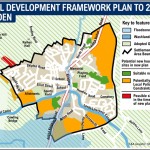![]() by David Knights
by David Knights

Bradford Council this week said it had no active plans to build an eastern bypass for Silsden.
But it said the feasibility of such a relief road – long demanded by residents to tackle town-centre congestion – could be investigated at any time. And it admitted a potential route had been drawn up in case preparations began in earnest.
The council outlined the situation following a request for clarification from the Keighley News. We last week revealed new hopes of a bypass, contained in a recent letter to Keighley MP John Grogan from Steve Hartley, the council’s strategic director of place.
Mr Hartley had written:
“The council will be embarking on work over the next 12 months or so as part of the district-wide Strategic Transport Model where further consideration will be given on the subject of a bypass for Silsden.”
In a statement this week, a council spokesman said there were “currently no plans” to build a bypass in Silsden, adding: “However, transport infrastructure is constantly reviewed so it responds to changes in traffic demands, available funding and scale and location of growth.
“If the council makes a decision to build a bypass, there is an indicative route set out in the current Local Plan which runs to the east of Silsden. This is very much a starting point. More detailed work is required to carefully consider transport demands and potential designs before the road could be considered for funding.”
In its statement this week, the council also clarified the position regarding its target for 1,200 new homes to be built in Silsden by 2030, as part of the Unitary Development Plan. The council admitted that although it had agreed a minimum target of new houses, this would not prevent further housing development in the area.
The spokesman said:
“The council has no powers to put a blanket ban on housing. Government policy supports housing growth generally and requires planning applications to be considered positively and approved as long as they are in line with the council’s Local Plan and national policy.
“Applications can only be refused if negative impacts significantly outweigh benefits of the development.”
The council said the Local Plan considered the full range of infrastructure needed to support growth to 2030. The spokesman added:
“Ongoing work with providers in sectors such as education and utilities seeks to ensure infrastructure keeps pace with housing growth. We also make sure developments can be accessed in an appropriate and safe way on the transport network.”
COMMENT
Jackie Thompson:
The Unitary Development Plan no longer exists and hasn’t since 2012 when the National Planning Policy Framework came in. UDPs were an initiative of the Labour Government which set housing targets for Local Authorities. The NPPF scrapped those targets. On top of this the Local Plan done under the NPPF was accompanied by an Infrastructure Plan which, if my recollection is correct, included a bypass for Silsden to enable the village to cope with traffic from new development. The NPPF is quite clear that new homes shouldn’t be built without the proper infrastructure.
It’s also worth noting that the vast majority of the 1200 homes the Council is planning for Silsden would be in greenbelt and that Government Policy states that greenbelt should not be built on except in exceptional circumstances. What are the exceptional circumstances the Council thinks apply here? According to the latest Government figures the number of households across the district is likely to grow by about 750 per annum in the coming years. That’s just 9000 between now and 2030. Are over thirteen per cent of them expected to be in Silsden. If so, why?








